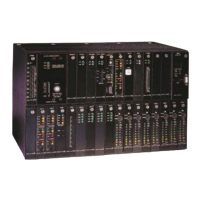D/I Mux III User’s Manual Appendix G. Modem Interfaces
257
Modem Considerations
There are a number of considerations to be taken into account when planning modem installation.
Among the problems that might be encountered are line noise, timing discrepancies, sequencing
difficulty, and control signalling errors. Each is described below.
Line Noise
Noise on the telephone line can inject data errors, can cause loss of carrier, and can and
terminate the connection. If the connection is dropped, and the result code has been enabled,
the modem will return a NO CARRIER message.
Command Timing
Certain modem commands and functions can take several moments to activate and complete.
Generally, however, the initialization response should occur in less than a half second, and
entering the auto-answer mode should take less than a half second.
Dialing time varies with the length of the number to be dialed, and any pauses in the dialing
string. For most telephone numbers, dialing should take less than 5 seconds. However, the
modem will not return a result until after either a preset time-out has occurred, or a complete
connection has been established with the called modem. Allow 30 seconds to elapse, prior to
connection, if the called modem has been configured to answer on the first ring.
A modem answers on the first detected ring. Due to central telephone office timing cycles,
however, an extra ringing cycle often occurs before the called modem actually sees ringing. This
additional time can be as long as 10 to 15 seconds. After answering the call, and going off hook,
the two modems attempt to establish a carrier signal. Various modulations will be tried until they
either match, or until the calling modem gives up.
If, during one of the longer time periods, either modem receives a character from its controlling
port, the current command is terminated, especially for the dial-out process mentioned above.
The modem immediately advances its time out period, and returns a NO CARRIER status.
Modem-To-Modem Sequencing
If two modems attempt to call each other at the same time, neither will be able to complete the
connection since each modem is attempting to originate the connection. (This is rare, but can
occur.)
Modem Control Lines
Modems track any changes in the Data Terminal Ready (DTR) and Ready To Send (RTS) signals
coming from a terminal. Not all modems permit changing the response DTR signalling (refer to
the &Dn command set in Table I-4 above for details).
Any fluctuations of the DTR signal can cause the modem to drop a connection. In early model
equipment (with older communications libraries), this was a problem. The older libraries disabled
DTR when a controlling program invoked and shelled to a child program. Even though the child
program re-enabled the DTR line, the modem would see the fluctuation and hang up.
The RTS signals the modem that the terminal wants to send data. The modem responds by
enabling the Clear To Send (CTS) signal. The CTS signal enables the terminal to send data.
Dial-Out Call Processing

